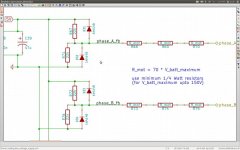Cool stuff

I had a look at the hex, apparently the current sensors are only 3.12 mV/A, are they 600 A sensors ?
Anyways, event at 150 A amplitude you're talking only 500mV (1Vpp) into the controller IC. Your error current settings
are 25A and 25A, so 80 to 160 mV. All these are quite low values keeping in mind the ADC's in the chip have about
5mV per LSB. Noise picked up between the current sensors and the controller IC will can have quite an impact with
these small signal amplitudes
If you want to use these sensors, have you considered looping the phase wires 3 or 4 times through the sensor ? This
would turn the 600A sensors into 200A or 150A sensors, and make 'm 9.36 mV/A or 12.48mV/A as far as the controller
IC is concerned. The effect of picked up noise would be reduced by a factor 3 to 4.
When you go to maximum 200A phase current, wouldn't ACS758 type sensors be a better choice ?
Did you have a look at the sine wave frequency on toolbags labview setup ? What was the real-life erpms reached ?

